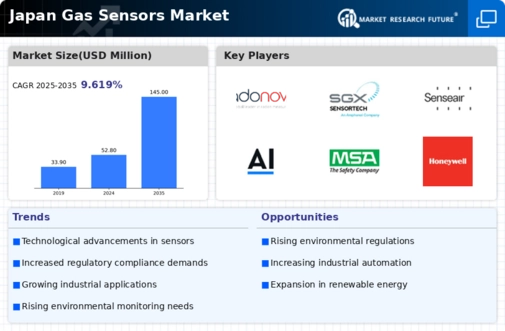Rising Industrial Demand
The gas sensors market in Japan is experiencing a notable surge in demand driven by the industrial sector. Industries such as manufacturing, oil and gas, and chemicals are increasingly adopting gas sensors to ensure safety and compliance with environmental regulations. The market is projected to grow at a CAGR of approximately 8% from 2025 to 2030, reflecting the critical need for real-time monitoring of hazardous gases. This trend is further supported by Japan's commitment to enhancing industrial safety standards, which necessitates the integration of advanced gas detection technologies. As industries expand and modernize, the reliance on gas sensors for operational efficiency and safety is likely to intensify, thereby propelling the gas sensors market forward.
Environmental Regulations
Japan's stringent environmental regulations are significantly influencing the gas sensors market. The government has implemented various policies aimed at reducing emissions and ensuring air quality, which necessitates the use of gas sensors for monitoring pollutants. The market is expected to witness a growth rate of around 7% annually as companies invest in compliance technologies. These regulations not only promote the adoption of gas sensors in industrial applications but also in residential and commercial sectors, where air quality monitoring is becoming increasingly important. The proactive stance of the Japanese government in enforcing environmental standards is likely to create a robust demand for gas sensors, thereby shaping the market landscape.
Advancements in Sensor Technology
The market is being propelled by advancements in sensor technology, which are enhancing the performance and reliability of gas detection systems. Innovations such as miniaturization, improved sensitivity, and integration with IoT devices are making gas sensors more effective and user-friendly. The market is expected to grow by about 8% as these technological improvements become more prevalent. Enhanced sensor capabilities allow for more accurate monitoring and quicker response times, which are critical in both industrial and residential applications. As technology continues to evolve, the gas sensors market is likely to see a shift towards more sophisticated solutions that meet the demands of modern applications.
Growing Awareness of Workplace Safety
There is an increasing emphasis on workplace safety in Japan, which is driving the gas sensors market. Companies are recognizing the importance of protecting employees from hazardous gas exposure, leading to a rise in the adoption of gas detection systems. The market is anticipated to expand at a rate of 6% as organizations invest in safety measures and training programs. This heightened awareness is not only a response to regulatory requirements but also a cultural shift towards prioritizing employee well-being. Consequently, the gas sensors market is likely to benefit from this trend, as businesses seek reliable solutions to mitigate risks associated with gas leaks and exposure.
Technological Integration in Smart Cities
The development of smart cities in Japan is fostering innovation in the gas sensors market. As urban areas evolve, the integration of smart technologies necessitates advanced gas detection systems for monitoring air quality and ensuring public safety. The market is projected to grow by approximately 9% as municipalities invest in smart infrastructure. Gas sensors play a pivotal role in these initiatives, providing real-time data that can be utilized for urban planning and emergency response. The collaboration between government bodies and technology providers is likely to enhance the capabilities of gas sensors, making them indispensable in the context of smart city development.






















Leave a Comment